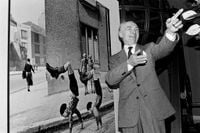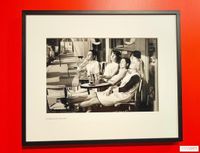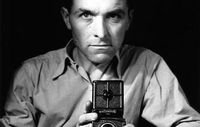The Maillol Museum in Paris is set to host a remarkable exhibition titled "Instants donnés," showcasing the extensive and intimate works of French photographer Robert Doisneau from April 17 to October 12, 2025. This exhibition features over 400 photographs selected from a staggering collection of 450,000 negatives held by the Doisneau Workshop, making it the largest retrospective dedicated to the iconic figure of humanistic photography in the last twenty years.
Doisneau, who lived from 1912 to 1994, is perhaps best known for his iconic image, "The Kiss of the Town Hall," captured in 1950. This black-and-white photograph, depicting a couple locked in a romantic embrace in front of the Paris town hall, has become a symbol of love in the City of Lights. However, Doisneau himself expressed concern over the simplicity of this image, stating, "This photo worries me a little: this success shows that it is a very, very easy thing, an easy effect." He was a master of storytelling and a keen observer of life, capturing the essence of Paris and its inhabitants with a unique blend of artistry and authenticity.
The exhibition presents a comprehensive journey through Doisneau's career, spanning from 1934 to 1992. It is organized thematically and chronologically, allowing visitors to explore various facets of his work. Notably, one section titled "Gravité" delves into the darker aspects of his photography, highlighting marginalized communities and the struggles of post-war French society. This thematic exploration reveals a more complex and audacious side of Doisneau, who not only documented everyday life but also engaged with the social issues of his time.
In addition to his well-known works, the exhibition also features lesser-known series that showcase Doisneau's versatility. For instance, the photographs of artists such as Pablo Picasso, Alberto Giacometti, and David Hockney reveal a side of Doisneau that intertwines the lives of celebrated figures with the everyday experiences of ordinary people. Annette Doisneau, the photographer's daughter, shared insights about one of these encounters, recalling, "There, it's Sabine Azéma," referring to a photograph of the actress taken on the set of Bertrand Tavernier's film "Un dimanche à la campagne." She noted that Azéma was one of her father's closest friends, alongside notable figures like cellist Maurice Baquet and poet Jacques Prévert.
The exhibition is not only a showcase of Doisneau's artistic achievements but also a heartfelt tribute from his family. Annette and her sister, Francine Deroudille, collaborated with curator Isabelle Benoit to curate the exhibition, diving deep into the archives of the Doisneau Workshop to craft a narrative that honors both the man and the artist. This personal touch is evident in the inclusion of personal items, unpublished documents, and immersive audio-visual experiences that invite visitors into Doisneau's world.
Doisneau's ability to capture the poetry of daily life is evident in his photographs of children, bistros, and street scenes. One of his famous works, "Mademoiselle Anita," taken in 1951, exemplifies his talent for infusing everyday moments with a sense of charm and nostalgia. He often remarked, "It is good to have a familiar bistro. Two, it's even better," reflecting his love for the intimate spaces of Parisian life.
Another significant piece, "The Bobin Factory in Montrouge," taken in 1945, illustrates his commitment to documenting the working class and the industrial changes of his time. Doisneau's lens captured the essence of a world in transformation, focusing on the lives of ordinary people and their struggles. His approach was characterized by a patient observation that allowed him to blend into the environments he photographed, earning him the reputation of a flâneur, a leisurely observer of the city.
The exhibition also highlights the evolution of Doisneau's work over the decades, showcasing photographs in both black and white and color. The latter includes images from the suburbs taken thirty years later, presenting a stark contrast between the vibrant life of the past and the increasingly dehumanized spaces of modernity. This juxtaposition serves as a poignant reminder of the changes that have shaped Paris and its communities.
Throughout the exhibition, visitors will encounter a variety of themes, including childhood innocence, the vibrancy of Parisian bistros, and the struggles of marginalized groups. The photographs are complemented by personal anecdotes and reflections from those who knew Doisneau, enriching the viewer's understanding of his artistic vision.
As the exhibition draws closer, excitement is building among photography enthusiasts and the general public alike. The Maillol Museum, located at 59-61, rue de Grenelle, 75007 Paris, is preparing to welcome visitors to this unique celebration of Robert Doisneau's legacy. With its blend of iconic images and personal narratives, "Instants donnés" promises to be an unforgettable experience for all who attend.
In a world that often rushes past the beauty of everyday moments, Doisneau's work serves as a reminder to pause and appreciate the simple joys of life. As he once said, "There are days when the simple act of seeing feels like true happiness." This exhibition is not just a retrospective; it is an invitation to rediscover the magic of the ordinary through the lens of one of photography's great masters.







